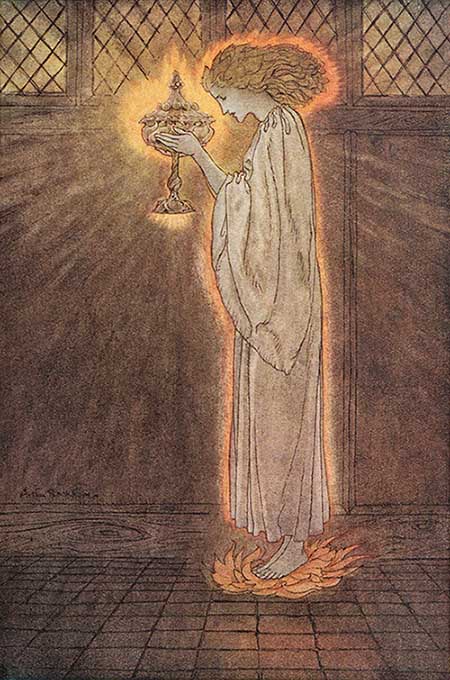Procession of the Grail
Ceremony of the Holy Grail, Procession of the Bleeding Lance, Procession of the Grail Castle, Procession of the Holy Vessel, Procession of the Sacred Relics, Ritual of the Sacred Cup
The Grail Procession is a recurring motif in Arthurian literature, typically depicted as an entourage of servants bearing sacred objects associated with the Grail. It is prominently featured in numerous Grail romances, often reaching its climax when witnessed by the protagonist, most notably Perceval.
Described in various Arthurian texts, the procession typically begins with the presentation of a Bleeding Lance, or spear symbolizing the spear used to wound Christ on the Cross. Other items carried in the procession may include candelabra, trestles, candles, stones, bowls, platters, and utensils, each imbued with symbolic significance.

The Grail Procession is first mentioned by Chrétien de Troyes, who provides a detailed account featuring the Bleeding Lance, a candelabra, the Grail itself, and a silver platter (Fisher King’s Carving Dish). These elements bear resemblance to descriptions of Byzantine mass rituals found in ancient manuscripts from the seventh or eighth centuries.
In Arthurian romance, the Grail Procession typically lacks a priest, distinguishing it from religious rituals. Instead, it is often orchestrated by mysterious figures associated with the Grail Castle, adding to the enigmatic nature of the scene.
One of the most famous depictions of the Grail Procession occurs in Chrétien’s work, where Perceval witnesses the procession led by squires bearing the Bleeding Lance and candlesticks, followed by a damsel carrying the Grail, and another damsel with a plate.
It is significant to note that the Grail Procession appears exclusively in narratives where Perceval is the hero who achieves the Grail, highlighting his pivotal role in the Grail Quest and the mystical events surrounding it.
The entourage of servants witnessed by Perceval (and other various knights) in the castle of the Fisher King. One of the servants, usually a maiden, carried the Grail.
Peredur, which does not feature a Grail per se, culminates with a bowl filled with blood in which floats the decaptitated head of Perceval’s uncle.
The procession observed by Percivale/Perceval at the Grail Castle when the Grail was carried, according to Chrétien by a squire with a bleeding lance, two squires carrying ten-branched candlesticks, a damsel with the Grail itself and a final damsel with a plate.
In the Didot Perceval, the procession consisted of two youths carrying a large spear from which blood freely flowed, followed by a damsel carrying a salver on which there was a head swimming in blood.
See also
Fisher King’s Candlesticks | The Legend of King Arthur
Fisher King’s Carving Dish | The Legend of King Arthur
Fisher King’s Table | The Legend of King Arthur
Grail Maiden | The Legend of King Arthur
Grail Spear | The Legend of King Arthur
Holy Lance | The Legend of King Arthur
Lance of Longinus | The Legend of King Arthur
Longinus’ Spear | The Legend of King Arthur
Sources
Perceval, or Le Conte del Graal | Chrétien de Troyes, late 12th century
Parzival | Wolfram von Eschenbach, 1200–1210
Diu Crône | Heinrich von dem Türlin, c. 1230
Peredur | 13th century
Image credit
The Grail Maiden | Artist: Arthur Rackham, 1917
